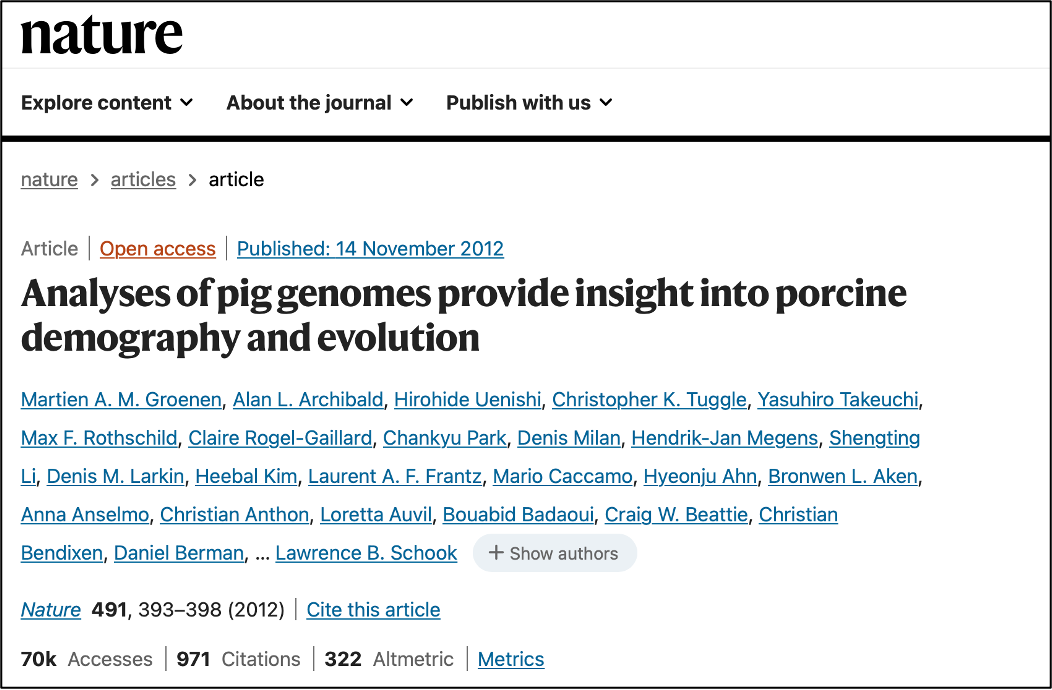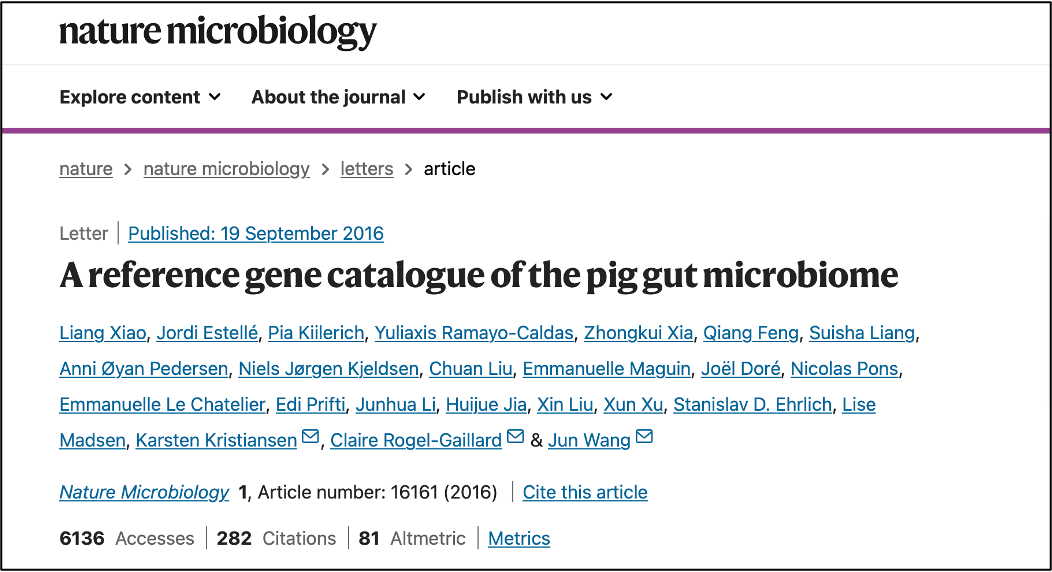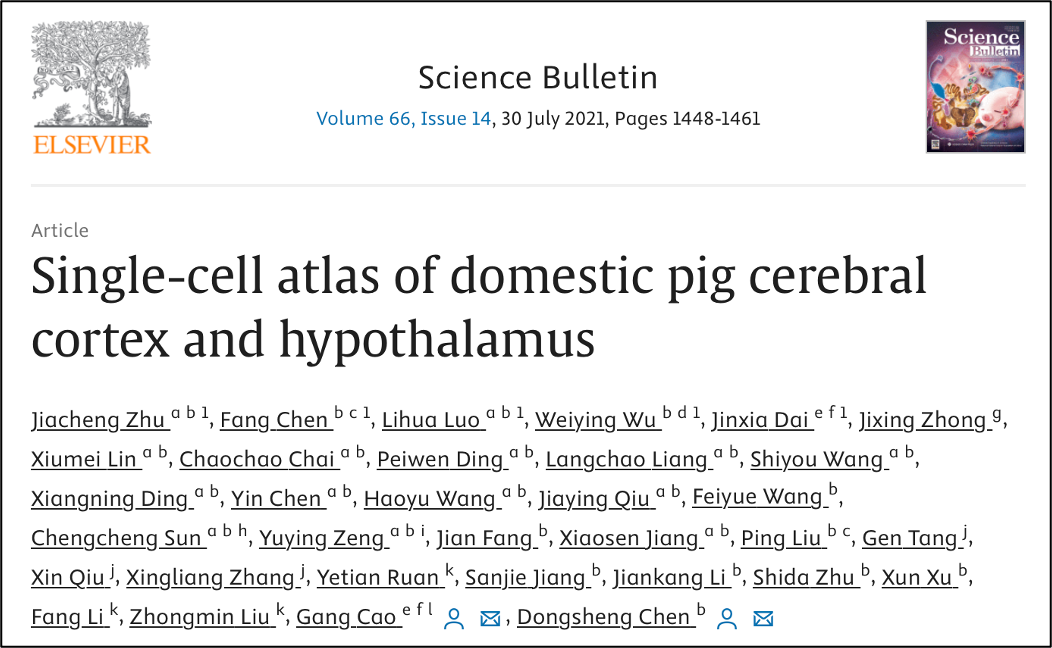Around 97 million years ago, the evolutionary ancestors of pigs and humans shared a close and complex relationship. As a result, genetically, pigs and humans share as much as 84% homology. This high degree of genetic similarity means that pigs can develop some complex genetic diseases common in humans, making them an ideal animal model for studying human diseases.
Pigs have been an important part of BGI’s research for many years. The development of new technologies and tools has enabled comprehensive studies involving whole-genome sequencing, analysis of pig gut microbiota, cross-species comparative research, and single-cell research. BGI's research outcomes have provided valuable model resources in biological fields such as neuroscience, regenerative medicine, and evolutionary development as we explore below.
In 2012, BGI contributed to two relevant studies on the whole-genome sequencing and analysis of pigs, which were published in the journals Nature and GigaScience. The research revealed that pigs possess over a hundred genetic loci where the porcine proteins have the same amino acids implicated in human diseases, including conditions like diabetes. The large-scale data associated with the pig genome contributes to the research of human diseases.
 2012 - " Analyses of pig genomes provide insight into porcine demography and evolution," was published in Nature.
2012 - " Analyses of pig genomes provide insight into porcine demography and evolution," was published in Nature.
 2012 - " The sequence and analysis of a Chinese pig genome," was published in GigaScience.
2012 - " The sequence and analysis of a Chinese pig genome," was published in GigaScience.
Four years later BGI, in collaboration with multiple institutions, established the world's first comprehensive pig gut microbiome gene reference catalog. The related findings were published in Nature Microbiology. This study is of significant importance for the scientific breeding of pigs as well as for human disease research using pigs as a model.
 2016 - " A reference gene catalogue of the pig gut microbiome," was published in Nature Microbiology.
2016 - " A reference gene catalogue of the pig gut microbiome," was published in Nature Microbiology.
Because pigs and humans are genetically close, it has often been thought that they could be leading candidates for xenotransplantation. However, differences at the cellular and molecular levels between pigs and humans necessitate further clinical improvements. Studying pigs at the single-cell and cross-species levels could address some of the developmental incompatibilities.
In March 2020, the Karolinska Institutet, in collaboration with BGI and other institutions, constructed a protein-coding gene atlas of the human, pig, and mouse brains. The findings were published in Science. A year later, in February 2021, BGI, in partnership with the University of Texas Southwestern Medical Center, conducted a first-of-its-kind analysis at the single-cell level to understand the differences in early embryonic development between pigs and primates. These results were published in Cell Discovery. This research achieved a breakthrough by obtaining single-cell data from extended-stage pig embryos. Through cross-species comparisons, it elucidated the developmental differences in early-stage embryos of different species. This provides crucial information for further studies on the barriers to interspecies chimera development.
 2020 - " An atlas of the protein-coding genes in the human, pig, and mouse brain," was published in Science.
2020 - " An atlas of the protein-coding genes in the human, pig, and mouse brain," was published in Science.
 2021 - " Cross-species single-cell transcriptomic analysis reveals pre-gastrulation developmental differences among pigs, monkeys, and humans," was published in Cell Discovery.
2021 - " Cross-species single-cell transcriptomic analysis reveals pre-gastrulation developmental differences among pigs, monkeys, and humans," was published in Cell Discovery.
The brain tissue of pigs also holds immense research value as it possesses a multi-gyrus structure similar to that of the human brain. In April 2021, BGI, in collaboration with Huazhong Agricultural University, constructed the first single-nucleus transcriptomic profiles of domestic pig brain tissue. The findings were published in Science Bulletin. This atlas provides insights into the composition of cell types within the pig brain and the interactions between them, indirectly aiding research into human neurological diseases.
 2021 - " Single-cell atlas of domestic pig cerebral cortex and hypothalamus," was published in Science Bulletin.
2021 - " Single-cell atlas of domestic pig cerebral cortex and hypothalamus," was published in Science Bulletin.
In June 2022, BGI and Aarhus University co-led research, joined by other institutions, to construct the first cell atlas of multiple tissues and organs in domestic pigs using single-cell transcriptome sequencing. This research published in Nature Communications confirmed the high degree of cellular and functional heterogeneity in pig endothelial cells. These discoveries provide key scientific resources for studying cardiovascular diseases in humans using domestic pigs and for improving immune rejection responses in xenotransplantation. They also hold significant importance for research into the evolutionary modules of microglia in human brain diseases.
 2022 - " Endothelial cell heterogeneity and microglia regulons revealed by a pig cell landscape at single-cell level," was published in Nature Communications.
2022 - " Endothelial cell heterogeneity and microglia regulons revealed by a pig cell landscape at single-cell level," was published in Nature Communications.
All these research papers demonstrate how animal models can be vital tools for studying human development and diseases, identifying effective treatments, and developing vaccines. Pigs play a special role because of their genetic closeness to humans, and with continuing research, it is hoped that answers can be found for multiple human diseases including brain and neurodegenerative diseases, heart diseases, lung diseases and cancer.
Source
Nature: Analyses of pig genomes provide insight into porcine demography and evolution
https://www.nature.com/articles/nature11622
Giga Science: The sequence and analysis of a Chinese pig genome
https://academic.oup.com/gigascience/article/1/1/2047-217X-1-16/2656144?searchresult=1
Nature Microbiology: A reference gene catalogue of the pig gut microbiome
https://www.nature.com/articles/nmicrobiol2016161
Science: An atlas of the protein-coding genes in the human, pig, and mouse brain
https://www.science.org/doi/10.1126/science.aay5947
Cell Discovery: Cross-species single-cell transcriptomic analysis reveals pre-gastrulation developmental differences among pigs, monkeys, and humans
https://www.nature.com/articles/s41421-020-00238-x
Science Bulletin: Single-cell atlas of domestic pig cerebral cortex and hypothalamus
https://www.sciencedirect.com/science/article/pii/S2095927321002589
Nature Communications: Endothelial cell heterogeneity and microglia regulons revealed by a pig cell landscape at single-cell level
https://www.nature.com/articles/s41467-022-31388-z



